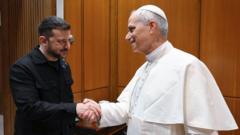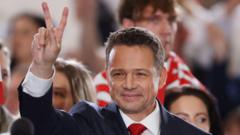As the conclave moves into its second day, the process continues under strict secrecy and the weight of diverse opinions shaping the future of the Catholic Church.
**Papal Conclave Enters Second Day: Awaiting a New Pope Amid Unprecedented Challenges**

**Papal Conclave Enters Second Day: Awaiting a New Pope Amid Unprecedented Challenges**
The Vatican conclave unfolds with 133 cardinals deliberating again, seeking a leader for 1.4 billion Catholics after Pope Francis's passing.
May 8, 2025, 8:00 a.m. ET
The papal conclave has resumed for its second day, as the 133 cardinals gather once more in the Sistine Chapel to seek consensus on the election of the next pope. Following the inconclusive voting on Wednesday—which yielded no candidate—a renewed round of discussions will occur, constrained by the vows of secrecy and the absence of modern communication tools.
Following the death of Pope Francis in April, his successor’s election marks a significant moment for the Roman Catholic Church, now facing both internal divisions and evolving social expectations. The election process is especially notable as this conclave is the largest in history, with many cardinals having been appointed by Francis himself, which brought them into strong focus for the ensuing debates.
Today's voting schedule includes two sessions in the morning and two in the afternoon. During the conclave, ballots are incinerated post-vote to signal consensus; black smoke reveals no consensus achieved, while white smoke indicates the selection of a new pope. Given the diverse and unfamiliar group dynamics, some cardinals suggest this may lengthen the process, diverging from the trend of previous quick elections.
Cardinal Timothy M. Dolan of New York has prepared himself for a longer process, while other cardinal electors counter that a familiar name may allow for a quicker resolution. Current speculation suggests Cardinal Pietro Parolin and Cardinal Luis Antonio Tagle as potential frontrunners, with the cardinals' preferences signaling the broader direction they wish the Church to take moving forward.
Earlier this morning, the cardinals attended Mass before their second voting session, as crowds began to gather in St. Peter’s Square, with observers discussing the potential impact of today’s decisions. The conclave's tradition of secrecy includes measures against modern technology, ensuring that any developments remain under wraps until an official announcement is made.
As the world watches, the deliberations of the cardinals hold the promise of both continuity and change, shaping the future direction of Catholic leadership in a time of significant global and ecclesial challenges.
The papal conclave has resumed for its second day, as the 133 cardinals gather once more in the Sistine Chapel to seek consensus on the election of the next pope. Following the inconclusive voting on Wednesday—which yielded no candidate—a renewed round of discussions will occur, constrained by the vows of secrecy and the absence of modern communication tools.
Following the death of Pope Francis in April, his successor’s election marks a significant moment for the Roman Catholic Church, now facing both internal divisions and evolving social expectations. The election process is especially notable as this conclave is the largest in history, with many cardinals having been appointed by Francis himself, which brought them into strong focus for the ensuing debates.
Today's voting schedule includes two sessions in the morning and two in the afternoon. During the conclave, ballots are incinerated post-vote to signal consensus; black smoke reveals no consensus achieved, while white smoke indicates the selection of a new pope. Given the diverse and unfamiliar group dynamics, some cardinals suggest this may lengthen the process, diverging from the trend of previous quick elections.
Cardinal Timothy M. Dolan of New York has prepared himself for a longer process, while other cardinal electors counter that a familiar name may allow for a quicker resolution. Current speculation suggests Cardinal Pietro Parolin and Cardinal Luis Antonio Tagle as potential frontrunners, with the cardinals' preferences signaling the broader direction they wish the Church to take moving forward.
Earlier this morning, the cardinals attended Mass before their second voting session, as crowds began to gather in St. Peter’s Square, with observers discussing the potential impact of today’s decisions. The conclave's tradition of secrecy includes measures against modern technology, ensuring that any developments remain under wraps until an official announcement is made.
As the world watches, the deliberations of the cardinals hold the promise of both continuity and change, shaping the future direction of Catholic leadership in a time of significant global and ecclesial challenges.




















